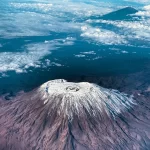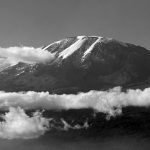MOUNT KILIMANJARO
Mount Kilimanjaro is Africa’s highest peak and the highest free standing mountain in the world. One of the largest volcano ever to burst through the earth’s crust. Mount Kilimanjaro rises high above the open African plains in Tanzania to an impressive 5895 meters (19340 feet).Two of the peaks are dormant but a third Kibo, shows signs of activity and is thought to still be live.
Kilimanjaro is so immense that it contains five climate zones, each about 1000m in height. From bush and grassland to dense rain forest, moorland, alpine desert and finally to the arctic zone with only rocks and ice. It is the journey from the tropics to arctic, all within the span of roughly a week. Climbing to the top of Africa’s Kilimanjaro is quite an accomplishment and can be achieved a lot easier if you are properly prepared for the trek. This means you need to take along the right clothing and equipment and be prepared for the altitude adjustment.
Conquering Mount Kilimanjaro means you will have to hike through rocky terrain, grassland and forest. You also need to be prepared for a variety of weather conditions including cold winds and hot sun. Make sure you cover your neck and face during the climb as they can easily blister. A windbreaker will also help as the wind is usually what drives the temperature down on the mountain.

There are six usual trekking routes to the summit. Many visitors how come here want either to see or climb Kilimanjaro, but there are more to see and do within the park’s borders. Day tour hiking to the Mandara hut on the Mount Kilimanjaro 7-8 hours walk.
Mount Kilimanjaro stands 5895 meters (19340) feet above sea level. Mount Kilimanjaro is the world’s most accessible high summit, most climbers reach the crater rim with little more than a walking stick, proper clothing, you need to be in a fit and healthy state with a good all-round condition and determination as well.
Creating tailor-made tours for over 10 years
Due to Tanzania’s close proximity to the equator, we generally only have two seasons; a rainy season and dry season. Short rainy season is from November to January and long rainy season is March through May. Dry season usually starts from July to October.
Majority of people will suggest that the best time to visit Tanzania is between July to October. This is the dry season, means that animals wandering searching for water, which makes them relatively easy to spot. You will probably see them in large concentrations as the watering points and rivers are getting limited. Most of the water’s sources dry up or get smaller during the dry season. However because most people believe that July to October is the best time to come, it is also the busiest time in the national parks. This means that majority of people miss the hidden treasures that can be found at other times of the year.
Here is a short overview of what the year looks like in our National Parks.
Ideas and travel guides for exploring Tanzania
High Season
- From June to October
- It is the dry season
- Climate: Dry and warm, although there is short rains between August and September
- Higher rates applied Great Migration Mara River crossing
Recommended Itineraries
- Great Migration River Crossing
- Kilimanjaro and Safari adventure
- Cultural and Great Migration experience
- Serengeti Migration and Zanzibar
- Kenya and Tanzania Game Safari
- Tanzania Camping Safari
Mid Season
- From November to February
- It is the short rains season
- Climate: Short rains, hot and dry in some days
- Average rates applied
- Great Migration Southern Serengeti (Calving Season)
Recommended Itineraries
- Special Green Season
- Wildebeest Migration and Cultural Safari
- Tanzania Signature Safari
- Tanzania Luxury Safari
- Tanzania Safari Adventure
Low Season
- From March to May
- Long rain season
- Climate: Rainy days, occasionally warm
- Lower rates applied
- Great Migration safari Southern to central Serengeti
Recommended Itineraries
- Special Green Season
- Tanzania Highlights Safari
- Wildebeest Migration and Cultural Safari


